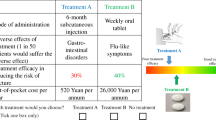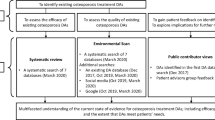Abstract
Summary
In Spain, various treatments are available to prevent osteoporotic fractures. A discrete choice experiment (DCE) was used to investigate the importance of different treatment aspects and its influence on patients’ preferences. All attributes included as type and place of drug administration as well as costs showed to be significant predictors of choice. Spanish osteoporosis patients have well-defined preferences and accept trade-offs among attributes.
Introduction
This study was designed to identify patient preferences for different aspects of osteoporosis treatments in Spain.
Methods
Main attributes of severe osteoporosis treatments were determined by literature review and consultations with nurses. The discrete choice experiment included three attributes: type of drug administration, place of administration, plus a cost attribute in order to estimate willingness to pay for improvements in attribute levels. A pilot study with 50 patients was performed to identify the areas of misunderstanding. One hundred sixty-six patients with a diagnosis of osteoporosis and severe osteoporosis were presented with pairs of hypothetical treatment profiles with different type of administration levels, places of administration and costs. Questions to collect socio-demographic and disease-related treatment data were also included. Data were analysed using a random effects probit model.
Results
All attributes had the expected polarity and were significant predictors of choice. Patients were willing to pay 183 €/month to have a subcutaneous injection once per day rather than an intravenous injection once per year. Patients with osteoporosis were willing to pay 121 €/month to have medical support when administering the drug treatment at home rather than being admitted several hours to a hospital for drug administration.
Conclusion
Spanish osteoporosis patients have well-defined preferences among treatment attributes and are willing to accept trade-offs among attributes. Participants indicated that they are willing to accept self medication with medical support rather than being hospitalised for several hours. The perspective of the patients should be taken into account when making treatment decisions.

Similar content being viewed by others
References
Bouza C, López T, Palma M, Amate JM (2007) Hospitalised osteoporotic vertebral fractures in Spain: analysis of the national hospital discharge registry. Osteoporos Int 18(5):649–657
Prevención de la osteoporosis (2009). El coste de la Desinformación del paciente. Available at: http://www.economiadelasalud.com/Ediciones/04/pdf/04_EnPortada_Prevencion.pdf. Accessed 24 February 2009
Vademecum España (2010) Drug tariff references to 2010. Available at: www.vademecum.es. Accessed 2 July 2010
Información de medicamentos autorizados en España (2006) Drug tariff references to 2006. Available at: http://www.imedicinas.com/GPTage/Home.php. Accessed 2 July 2010
Guía de prescripción terapéutica (2009). Información de medicamentos autorizados en España. Available at: http://www.imedicinas.com/GPTage/Search.php?text=osteoporosis. Accessed 24 February 2009
Greenfield S, Kaplan S, Ware JE Jr (1985) Expanding patient involvement in care. Effects on patient outcomes. Ann Intern Med 102:520–528
Edworthy SM, Devins GM (1999) Improving medication adherence though patient education distinguishing between appropriate and inappropriate utilization. J Rheumatol 26:1793–1801
Daltroy LH (1993) Doctor-patient communication in rheumatological disorders. Baillières Clin Rheumatol 7:221–239
Solomon DH, Avorn J, Katz JN et al (2005) Compliance with osteoporosis medication. Arch Intern Med 165:2414–2419
de Bekker-Grob EW, Essink-Bot ML, Meerding WJ et al (2008) Patients’ preferences for osteoporosis drug treatment: a discrete choice experiment. Osteoporos Int 19:1029–1037
Fraenkel L, Gulanski B, Wittink D (2006) Patient Treatment Preferences for Osteoporosis. Arthritis Rheum 55(5):729–735
Assessment of fracture risk and its application to screening for postmenopausal osteoporosis. Report of a WHO Study Group. Geneva, World Health Organization, 1994 (WHO Technical Report Series, No. 843)
Green W (1998) LIMDEP Version 8, Users Manual. Econometric Software Inc
Propper C (1995) The disutility of time spent on the United Kingdom’s National Health Service waiting lists. J Hum Resour 30:677–700
de Bekker-Grob EW, Essink-Bot ML, Meerding WJ et al (2009) Preferences of GPs and patients for preventive osteoporosis drug treatment. A Discrete-choice experiment Pharmacoeconomics 27(3):211–219
Ryan M (1999) Using conjoint analysis to take account of patient preferences and go beyond health outcomes: an application to in vitro fertilisation. Soc Sci Med 48:535–546
San Miguel F, Ryan M, McIntosh E (2000) Applying conjoint analysis in economic evaluations: an application to menorragia. Appl Econ 32:823–833
Lloyd A, McIntosh E, Price M (2005) The importance of drug adverse effects compared with seizure control for people with epilepsy. A Discrete choice experiment. Pharmacoeconomics 23(11):1167–1181
Acknowledgements
The authors gratefully acknowledge the participation of the nurses and the centres involved in this study: María Alvarez Balbona, Department of Rheumatology, Hospital La Paz, Madrid; Amelia Carbonell, Department of Rheumatology, Hospital San Juan de Alicante; Pilar Cavero, Department of Traumatology, Hospital Miguel Servet, Zaragoza; Montserrat Jordana, Department of Rheumatology, Hospital de Bellvitge, Barcelona; Carmen Prieto, Department of Traumatology, Hospital Alvarez Buylla, Asturias; Ángeles Molina, Department of Rheumatology, Hospital San Cecilio, Granada; Isabel Padró, Department of Rheumatology, Hospital del Mar, Barcelona; Elena Martínez, Medical department, Nycomed Pharma.
Conflicts of interest
Funding for the patients’ preferences for osteoporosis treatment study was obtained from Nycomed Pharma. The funding body had no role in the design of the study, in the analysis of the data and in the writing of the report.
Author information
Authors and Affiliations
Corresponding author
Rights and permissions
About this article
Cite this article
Darbà, J., Restovic, G., Kaskens, L. et al. Patient preferences for osteoporosis in Spain: a discrete choice experiment. Osteoporos Int 22, 1947–1954 (2011). https://doi.org/10.1007/s00198-010-1382-3
Received:
Accepted:
Published:
Issue Date:
DOI: https://doi.org/10.1007/s00198-010-1382-3




